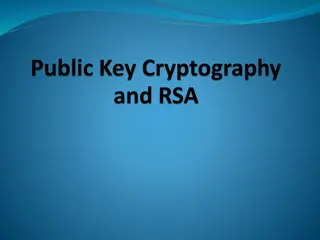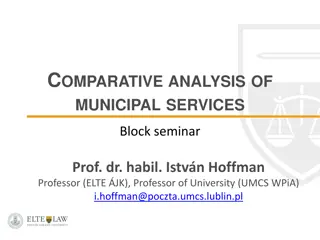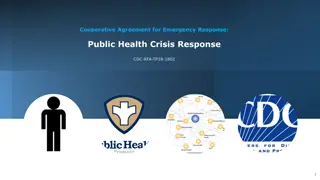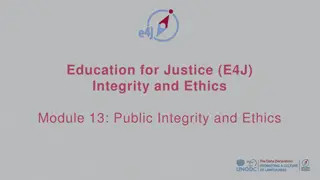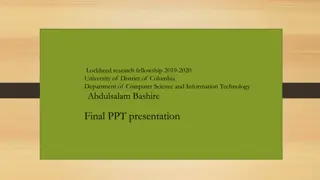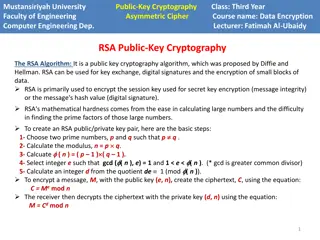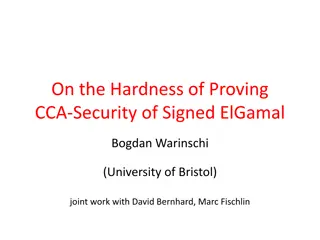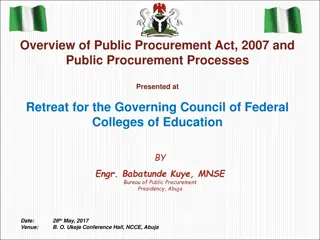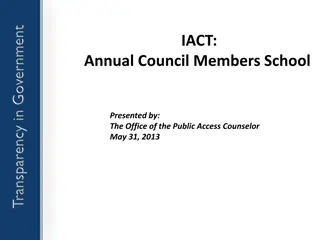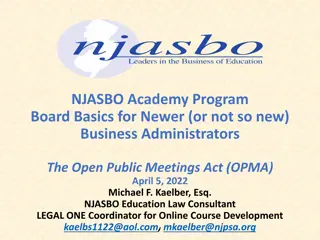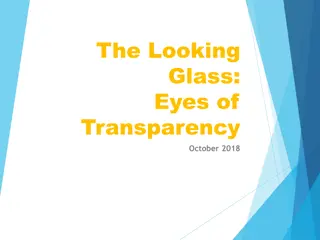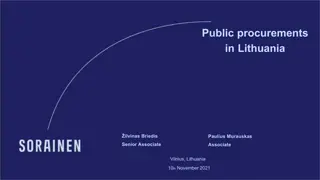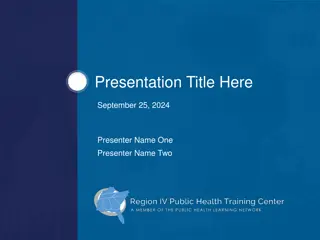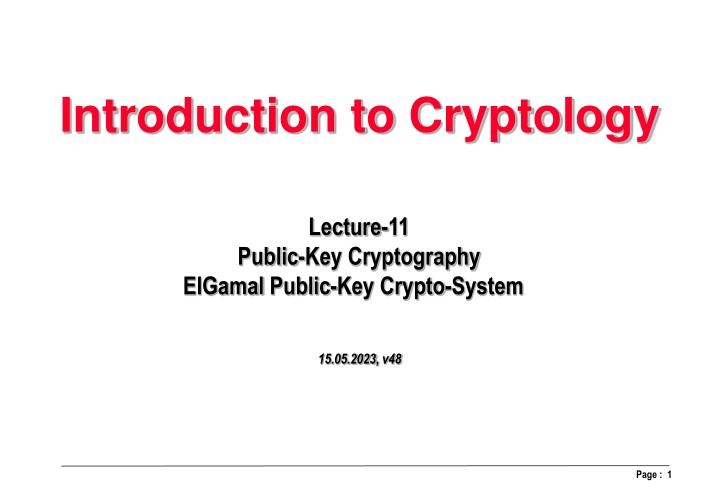
ElGamal Cryptography: Basics and Security Considerations
Explore the fundamentals of ElGamal Cryptography, including the public-key encryption and signature systems, security considerations, historical background, and practical applications such as message encryption and decryption. Learn about the innovative use of arithmetic in GF(q) for encryption and the key generation process. Dive into the complexity of creating and safeguarding secret keys, understanding the necessity of a public directory and the role of primitive elements in GF(q). Delve into the intricacies of the ElGamal Secrecy System and its encryption and decryption processes, with insights into key generation and secure communication protocols.
Download Presentation

Please find below an Image/Link to download the presentation.
The content on the website is provided AS IS for your information and personal use only. It may not be sold, licensed, or shared on other websites without obtaining consent from the author. If you encounter any issues during the download, it is possible that the publisher has removed the file from their server.
You are allowed to download the files provided on this website for personal or commercial use, subject to the condition that they are used lawfully. All files are the property of their respective owners.
The content on the website is provided AS IS for your information and personal use only. It may not be sold, licensed, or shared on other websites without obtaining consent from the author.
E N D
Presentation Transcript
Introduction to Cryptology Lecture-11 Public-Key Cryptography ElGamal Public-Key Crypto-System 15.05.2023, v48 Page : 1
Lecture Outlines Public-key Objective ElGamal Public-Key Encryption System ElGamal Public-Key Signature System ElGamal Security considerations Public Key Signature Standard Page : 2
The Target of Public Key Cryptography Ciphering Receiver De-Ciphering Sender Y = E (Z,X) E ( Z,X ) X X D ( Z,Y ) Message Message Channel Z Z Secret Key Channel Public-Key Register drops out the need for secret key- agreement completely Secret Key = Z Page : 3
ElGamal Crypto-System, 1985 Taher ElGamal Taher ElGamal: BsC, EE from Cairo University, MsC and PhD Stanford University advisor M. Hellmann ElGamal Cryptosystem became a NIST standard called DSA in 1994. Basic idea: Multiplication instead of exponentiation Page : 4
ElGamal Crypto-System 1985 Basic idea: Multiplication instead of exponentiation M M X X M Z =C Z-1 Z The inverse key Z-1 should not be computable if Z is known Is that possible?: Yes, By using groups arithmetic in in GF ! Page : 5
ElGamal Crypto-System 1985 Basic idea: Multiplication instead of exponentiation for encryption That is possible by using arithmetic in in GF(q) ! Public directory: primitive element in GF(q) Receiver Sender Secret Key = x Open Key y= X y = X M M X X C = M . X . R -X . R R Z = yR = x R Z-1 = ( R) x= -X . R This is actually DH-key! R= Random secret generated ad-hoc by sender Page : 6
ElGamal Secrecy-System (1985) User B decrypts User A encrypts M to B primitive element in GF(p) ya= Xapublic key of A yb= Xbpublic key of B Xa = secret key of A Xa Xb = secret key of B Xb C M C = M . Xb . R X X M / m Z-1 = -Xb. R Z = Xb. R yb (yb)R - Xb r = R r (r)-Xb = -Xb. R / R m-bits R m = log2p - Xb = (p-1) - Xb Random Generator : R = 1 ... p-1 Notice 1: a new R is needed for every M! Otherwise, Z can be easily revealed if M is known! Notice 2: The scheme applies similarly over GF(2m) , with as a primitive element in GF(2m) . Page : 7
Example 1: Setup ElGamal Encryption System using GF(11). Send the message M=10 from user A to B. The secret key of B is6and for A is 7 Solution : Computing order of =2: 22=4 1, 23=8, 24=5, 25=10 1, => order of 2 is 10 => 2 is a primitive element !. p=11=2 . 5+1, Possible orders = divisors of p-1=2x5, that is 1,2,5,10. User A sends M to B User B receives = 2 = primitive element in GF(11) ya= Xapublic key of A = 7 yb= Xbpublic key of B = 9 Xa = secret key of A=7 7= 7 Xb =6= secret key of B Yb= Xb= 26= 9 M =32 mod 11 =10 C=8 M=10 X X C = M . Xb . R = 10 . 3 =8 Z=98 = (2 6)8 = 248 mod 10 =28 =3 (4) yb (9)R r =28 =3 r=3 (3)-Xb= (3)4 =4 - Xb = -6 R R=8 Notice : If an attacker knows one message, say M=10 The ecryption key Z can be revealed simply as Z= M-1.C= 10-1.8 mod 11 =3 -Xb = (p-1) Xb -Xb = (11-1)-6 = 4 Random Generator : R = 1 ... p-1 , we select R= 8 Page : 8
ElGamal Crypto-System (1985) Advantages Disadvantages The cryptogram needs more bits than the plaintext (double) A new random is needed for every encrypted message Asymmetric workload: bad for some applications based on discrete logarithm problem Security is as that of DH system DL problem needs less key-bits than RSA for the same security Asymmetric workload: good for some applications ElGamal encryption is probabilistic, meaning that a single plaintext would be encrypted to many possible ciphertexts as a new random R is required for each encrypted block.. Page : 9
ElGamal Signature Scheme public directory User A signs M Verifier is primitive in GF(p) Xa= Secret Key of A ya= public key of A p, , ya Xa= ya If M M M = yar. r S mod p k-1( M - r . Xa) mod (p-1) = S S Then M is authentic. User A cannot deny having signed message M r = k r k k Random unit in Zp-1 That is: gcd (k, p-1 ) = 1 Signed Message Page : 10
Digital Signature Standard DSS (1994) Explicit true signature based on ElGamal Signature System (1985) Secure Hash Algorithm (SHA) see later M Data digest (compression) using Hash functions H(M) 160 bits k Digital Signature Algorithm (DSA) Random Source 160 bits 160 bits ( r , S ) M Signature Signed Message Page : 11
Digital Signature Algorithm DSA Standardized (1994) Based on ElGamal Signature Scheme public directory User A signs M Verifier is element in GF(p) with order q where q = large prime (160 bits) (q divides p-1 ) ya= public key of A Xa= Secret Key of A Xa= ya p, q, , ya If M M or H(M) 160 bits Rq(r . S-1) k-1( H(M) + r . Xa) in GF(q) = S Rq(M . S-1) Rp[ . ya ] = U S 160 bits k Rq[ Rp( k) ] = r r r = Rq( U ) k Random unit in GF(q) For which gcd (q,k)=1 is valid k = 1 to q-1 (160 bit) - p is a prime with 512 ... 1024 bits, q divides p-1 with a size of 160 bits, - fresh k is required for every message! Then M is authentic Signed Message Page : 12
Example 2: 1. Sign the message M=6 by using the Digital Signature Algorithm DSA, Use GF(p)=GF(11). 2. Check the resulting electronic signature Solution: Computing order of =3: 32=9 1, 33=5, 34=4, 35=1 => order of 3 is 5 P=11=2 . 5+1, Possible orders = divisors of p-1=2x5, that is 1,2,5,10. Select q=5 public directory User A signs M Verifier =3 is element in GF(p=11) with order q=5 where 5 = large prime Xa= Secret Key of A =3 ya=33= 5 in GF(11) p, q, , ya ya = 5= public key of A 11, 5, 3, 5 M = 6 or H(M) If M=6 Rq(r . S-1) Rq(M . S-1) k-1( M + r . Xa) in GF(q)=3(6+4x3) mod 5=4 = S Rp[ . ya ] = U S=4 R5[ R11(32) ] = 4 = r r=4 Check if r = Rq( U ) 4 = R5( 9 ) 4 = 4 K=2 K=2 Random invertible mod (q=5) K-1= 3 (mod 5) Signed Message M=6 This true, Thus M is authentic R5(6 . 4 ) U=R11[3 . 5 R5(4 . 4) ] = 9 Page : 13
ElGamal Signature System (1985), DSS (1994) Disadvantages A new random is required to sign every message more computations than RSA are needed DSS may be less secure than RSA as the security in GF(q) with the order of about 160 Bits Advantages Computations on Signer site are less complex than verifier site Security is based on the discrete logarithm problem which is still seen as computationally infeasible. Page : 14
Security of ElGamal Public Key Crypto-System (Equivalent to DH system) Security considerations and known facts: 1. Based on the assumption/claim that the discrete logarithm is still not efficiently computable according to the public literature A primitive element from GF(p) or GF(2m) is used to make exhaustive search algorithms infeasible. If y = t, only y and are known. To break the system, we need to find t. To get t , is repeatedly multiplied by itself i times when i=y, then t=i. The order of (as a primitive element) is p-1 in GF(p) or 2m-1 in GF(2m). Therefore, p is selected as 1000 to 4000 bits prime or m> 1000. Caution: There is no evidence that no efficient algorithms can be found to break the system. p-1 should have large prime factor to make the discrete logarithm computation infeasible (p is called a strong prime). 2. 3. 4. Page : 15
Hash Functions Hash functions are needed to generate message digest Iterated Hash Function: generates a digest of the data after being sequentially processed through the so-called Hash function. In general as follows: Input String X = (x1x2...xi.... xn) Output H is the digest of Input X : Hi Hash Mapping xi H = Hash(H0, X) N bits: size of hash value (digest) Non-linear state machine Hi-1 H0Initial value memory Example: SHA (Secure Hash Algorithm) proposed as a standard with DSA with N=160 bits (exposed to many attacks !) not more recommended !!! Page : 16
Few Recommended Practical Hash Functions by deploying Block Ciphers Page : 17
Hash Functions Based on block ciphers DM Scheme (Davis and Meyer) Cipher key length = Hash Block length = N Hi-1 Digest of Input X is: H = Hash(H0, X) BC: Block Cipher x Y Hi / KEY N / N Input String X = (x1x2...xi.... xn) Hi= Exi(Hi-1) Hi-1 Page : 18
Hash Functions Based on block ciphers LM Scheme (Lai and Massey 1992) Cipher key length = 2 x Cipher block length N Hi-1 Digest of Input X is: H = E (H0, X) BC: Block Cipher Hi / KEY N N / / N Hi= E (Hi-1) Input String X = (x1x2...xi.... xn) Hi-1| xi Page : 19
Traditional Hash Functions Based on deploying block ciphers (BC) (well known constellations. See NIST standards) BC: Block Cipher xi xi state g: key size adapter Hi-1 Hi-1 X Hi-1 xi g BC g BC BC key Y Hi Hi Hi Matyas-Meyer-Oseas Miyaguchi-Preneel Davis-Meyer Page : 20
Block-Cipher based Hash Functions alternatives 1/2 Source: Handbook of Applied Cryptography by Alfred J. Menezes, Paul C. Van Oorschot, Scott A. Vanstone, CRC Press (October 16, 1996) (available free of charge on the WEB) Page : 21
Block-Cipher based Hash Functions alternatives 2/2 Source: Handbook of Applied Cryptography by Alfred J. Menezes, Paul C. Van Oorschot, Scott A. Vanstone, CRC Press (October 16, 1996) (available free of charge on the WEB) Page : 22



